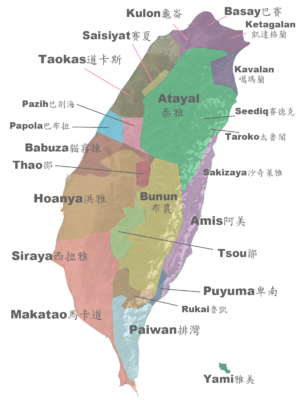This whole caricature of Taiwanese history is simply not true. Recent genetic studies have shown that 80 percent of Taiwan's population also have Austronesian ancestry (basically all of those who did not come over with the Chinese refugees in 1949).
Here is a more accurate account of Taiwan's history. Before Chinese immigrants came to Taiwan, Taiwan's mountains, foothills and plains were already populated by a multitude of Austronesian tribes and languages. Population density was varied, but there were settlements in every type of area of Taiwan.
First the Dutch came in the early 1600's and began to exert control over some parts of western Taiwan. They wanted a steady tax base, so they imported mostly Fujianese (Hoklo) laborers along with water buffalo to create an intensive rice agricultural economy in the flatlands. Before this time, there was no significant Chinese presence. Chinese pirates maintained a few bases in estuaries on the west coast.
At the end of the Dutch era, along with Koxinga, Hoklo immigrants came in greater numbers. By the 1700's Taiwan's west coast had come under the control of the Manchu empire. The Manchu regime did not want Chinese immigrants to settle in Taiwan so they only allowed men without their families to cross the Taiwan Strait to work. So naturally these men took Austronesian wives. Also, as the Chinese population grew in Taiwan, it became the dominant culture and the plains tribes gradually were assimilated and took on Chinese surnames. Various Hakka groups also crossed the Taiwan Strait and as they were already used to an upland economy based on mining and indigo and the farming of other upland crops, they came and settled the cheap wastelands of the hills, but were able to make them productive. There was some dislocation of Austronesian tribes, but on the whole the Austronesian plains tribes did not move to the mountains; they assimilated and became what is now the Hoklo and Hakka speaking populations of the majority of the people of Taiwan, now called "Taiwanese". Examples include the Siraya, Pazeh, Ketagalan, Kavalan, etc. to name a few.
Here is an article about how the Pazeh Austronesian tribe that assimilated in the early 1900's is seeking now to take back their language and culture.
A similar thing is happening in Tainan with descendents of the assimilated Siraya tribes who took on very unique Chinese surnames when they lost their own cultures. On July 4-7, 2008, they gathered to plan on reviving the now dead Sinkang Siraya language that their ancestor's spoke. They have begun publishing material in Siraya. You can see here how they realize that a language in these present times must be written, not just spoken, to have a hope of being revived. [Contact information: Uma Talavan (06)580.0992 , musuhapa at hotmail.com]
Here is a link to the map of Taiwan showing the distribution of Austronesian languages, even the ones that were culturally obliterated by Sinification.

